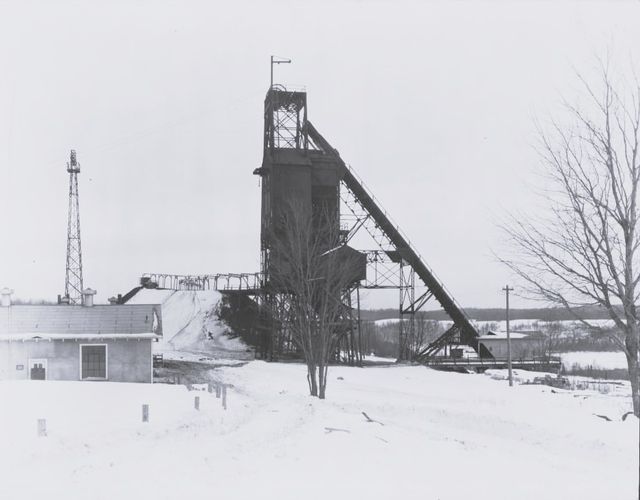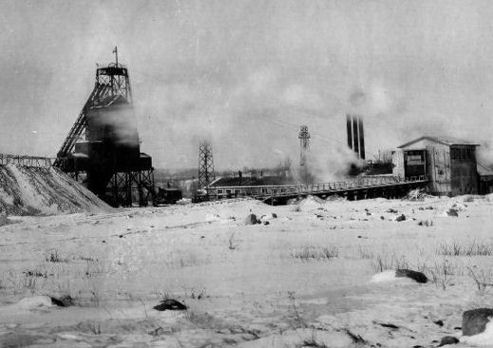- Details
- Hits: 2816
Mine: Imperial Mine, Michigamme, MI
Wetmore Mine → Imperial Mine → Abandoned
Operated for 52 years (including 8 suspension years).
From: 1881
Owned by: Cleveland Cliffs Iron Company until 1913. Reopened 1921 by Ford Motor Co.
Produced: Iron Ore, soft, brownish-yellow, high phosphorus, crushed.
Method: Underground, worked by top-slicing method.
Railroad connection:DSS&A to Marquette dock; C&NW to Escanaba dock.
Until: Operations suspended in 1913, reopened in 1921. Abandoned in 1933.
Lifetime Production: 2,057,781 ttons from 1882 to 1933.

 Image info: Top, a 1924 view of the Imperial Mine. 2nd image, the Imperial Mine in Baraga County in the early 1900's. [MINARC]
Image info: Top, a 1924 view of the Imperial Mine. 2nd image, the Imperial Mine in Baraga County in the early 1900's. [MINARC]
Notes
In Baraga County. Closed from 1913 to 1921.
NW Section 25 of T48N-R31W.
Once called the Farm or Wetmore mine. Operated by Cleveland Cliffs Iron Co. Reopened in 1921 by Ford Motor Co.
Time Line
1890. November. Capt. Tim Kurby, who has had charger of the Imperial Mine at Michigamme since its opening, has resigned. [OT-1890-1107]
1900. At the Imperial Mine the ore secured during the season has been from open cut. They are sinking a shaft and are opening out rooms from the hanging of the open pit which gives a fine stoping fact. [BHN-1900-0106]
1900. October. The Imperial mine is closing down, letting out about 150 men. [DFP-1900-1026]
1910. July. The CCI company which is operating the Imperial mine is employing about 150 men. [LAS-1910-0702]
1911. The Imperial iron mine, the only producing mine in Baraga county located in Spurr Township, will close down tonight, throwing 125 men out of employment. Considerable building has been done at the mine this year, an engine house and other buildings being erected. [LAS-1911-1007]
1920. Reports from Marquette county last week that Mr. Ford intends to operate the Imperial Mine west of Michigamme. This property is on the Michigan Iron & Land Company's purchase and is a low grade limonite ore that the CCI people were unable to handle at a profit and for that reason they released the mine from the lease that they held upon it. [DD-1920-1030]
1920. The announcement that Henry Ford will open the Imperial mine in Spurr township has been gladly received by the residents of that place. Engineers and metallurgists in the employ of Mr. Ford, whose recent land purchases included the Imperial Mine, recently examined the property and found it to be in good condition. The mine is located in Baraga county and a short distance from Michigamme. The mine was opened in 1882 and leased by CCI, who operated it for several years, giving it up in April, 1919. The CCI built a substantial steel headframe that is still in position near the shaft. The workings of the mine are shallow and are less than 200 feet below the surface with ore of a limonite, non-Bessemer grade. The mine buildings are still intact and will only require a short time to unwater the workings and begin operations. [LAS-1920-1029]
1921. Henry Ford has opened the Imperial Mine with 15 men preparing the way for rush work. Captain Albert Richards is in charge and he will tear down the old buildings, build new ones, and install electricity. The plant will be electrically operated throughout. The main shaft, down 400 feet, will be pumped out and new mining machinery put in. [CCH-1921-0812]
1922. Differing from other mines in the Michigan iron and copper fields, the men walk down and up stairways to and from their work, instead of being hauled down and up in cages. The step was taken as a safety measure Superintendent Richards explained. [DFP-1922-0725]
1922. The Imperial Mine shipped 73,083 tons of iron ore during the period of navigation just closed. This was less than the estimates, due to the fact that it was difficult to obtain lake transportation during the latter part of the season and some ore had to remain in stock. The Imperial is being worked two shifts. The ore is shipped to Ford's furnaces at River Rouge, where it is mixed with ores of other grades. [LAS-1922-1229]
1923. A car of hog fuel is being shipped daily from the L'Anse saw mill to the Imperial Mine at Spurr, the first car being shipped last Saturday. When the new hog is installed and the burner taken down shipment of this fuel will be increased. [LAS-1923-0202] Note: "Hog fuel" is a wood residue and waste product that is processed through a chipper or mill and produces coarse chips and clumps normally used for fuel. It also includes bark, sawdust, planer shavings, wood chunks, fines, and dirt. [GOOG]
1923. April. Two loaded cars of hog fuel ran away last Monday at the Imperial Mine in Spurr Township, and getting onto the main line of the South Shore crashed into freight train No. 55, almost completely wrecking the locomotive. The accident was said to have been caused by not leaving a switch properly set at the mine. The wrecked engine was taken to Marquette for repairs. [LAS-1923-0413]
1923. August. Henry Ford, the nation's motor king, Thomas A. Edison, famous inventor and Harvey P. Firestone, tire manufacturer, on their annual motor camping tour arrived in Escanaba. They proceeded to Iron Mountain, Michigamme, Sidnaw and L'Anse. Edison and the ladies boarded a yacht. Messrs. Ford, Firestone and Kingsford spent over an hour inspecting the L'Anse saw mill. The tourists have been traveling in three Lincoln cars and have three supply cars. One of the interesting pieces of camp paraphernalia is the dining table, which is circular and built in two sections, with a revolving center, made so that any person may serve himself by turning it around. Each car is driven by a chauffeur and there is a Japanese cook and helper in the camp staff. Moving picture men have been with the party since it left Detroit. The party was given a rousing reception at the Imperial Mine and the party then left for Sidnaw, where the Ford Motor company has ideal lumber camps. [LAS-1923-0824]
1923. The last ton of ore at the Imperial Mine has been loaded and shipped. Early in the spring the stockpile contained more than 200,000 tons. For the last few weeks 40 cars a day were sent out from the mine. Four train crews were kept busy at Michigamme by the South Shore railroad. [DFP-1923-0831]

